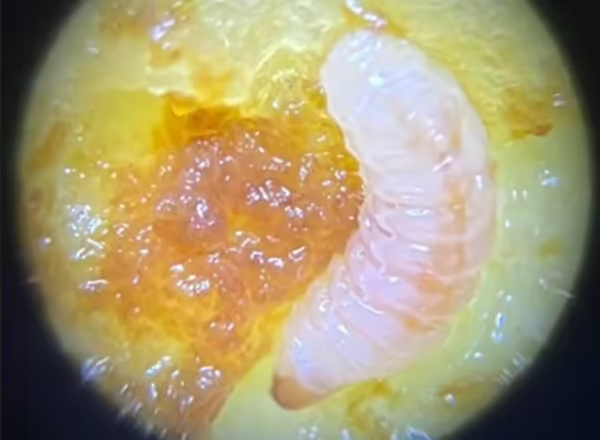
Plum curculio has been a growing problem in most peach and apple orchards in Illinois. A small weevil, laying eggs inside the fruit, is quite destructive to the peaches and apples. Traditionally, we have diagnosed this problem through the crescent-shaped scar that appears on fruit as a result of egg laying. Our observations suggest that this is common in apples but does not seem to occur in peaches.
Plum curculio emerge from their overwintering sites and move to the orchard in early spring. Border rows/perimeter trees are where you see the first sign of plum curculio damage. You want to monitor for adult plum curculio activity and time sprays for when the adults are active. Once the adults lay the eggs in the fruit, it is too late to spray. We have traditionally recommended sprays only in the spring for this pest as we had one generation in most of Illinois. It should be noted that our research in 2023 suggests that there is a second generation of plum curculio in the major peach growing regions of Illinois.
For the first generation on peaches, you want to time the insecticides during petal fall through shuck split. There are several insecticides from different classes that are recommended for plum curculio. There are several Pyrethroids (Asana, Baythroid, Danitol, Mustang Maxx, Permethrin, ProAxis, Warrior II), and a few neonicotinoids (Actara, Belay, Assail) recommended for its control. You can also use Apta, Avaunt, and Exirel. Avaunt has excellent control of plum curculio while the others have reasonable control as recommended by the Midwest Fruit Pest Management Guide.
However, it is important to rotate insecticides across different classes to minimize the risk of resistance. Pay close attention to the bee label on insecticides, indicating toxicity to bees, and adhere to the pre-harvest intervals (PHI) specified for each insecticide. This is especially true for the second generation.
Orchard sanitation plays a vital role in plum curculio control. Removing fallen fruit from the orchard helps reduce the larval population that pupates in the soil. You can also shake trees in the orchard to check whether the fruit falls. If the fruits fall quickly, they are likely infested with plum curculio.
In our efforts to develop an IPM strategy for plum curculio on peaches, monitoring adult activity using various traps and lures is our first step for the 2024 season. We are testing two trap types – trunk and pyramid traps – with a lure combination of Methyl salicylate and Grandiosic acid to enhance monitoring accuracy. By implementing better monitoring practices and reducing the use of insecticides, we aim to manage the population of plum curculio in growers' commercial orchards.
Stay tuned to our updates on plum curculio monitoring and management! Download the Plum Curculio infosheet.
This update was submitted by Kacie Athey and Karuna Kafle, graduate student in the Crop Sciences department at University of Illinois.
